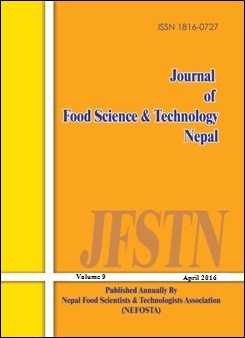Effect of Different Dress Weight Categories on Yield Part Percentage and Relationship of Live and Dress Weight of Broiler Carcasses Slaughter at Different Conditions
DOI:
https://doi.org/10.3126/jfstn.v9i0.14760Keywords:
Live weight, dress weight, cage system, transport distanceAbstract
Commercially reared mixed sex broilers were utilized to determine the effect of dress carcass weight on percentage yield of broiler parts, breast meat yield in weight category of <1.0, 1.0-1.2, 1.2-1.4, 1.4-1.6, 1.6-1.8, 1.8-2.0 and >2.0 kg. Then pH, cooking yield and moisture content of the breast meat with different time intervals (0 hours, 12 hours, 24 hours, 36 hours, 48 hours) and proximate compositions of meat were measured. Percentage yield of whole leg, thigh, breast, back and rib, neck, wings, gizzards, heart, liver, drumstick and total giblet were significantly affected by dress carcass weight at p<0.05. Yield of body components changed with the increasing body weight. pH values was significantly affected by time after slaughtering and finally it's reduced up to 5.69 at 48 hr after slaughtering. Suitable processing weight of broiler carcass to gain maximum breast yield is >2.0 kg which could be obtained highest fillet yield. To gain highest cooking yield (83.55%), carcass should be cooked immediately after slaughtering. Regression analyses revealed that linear relationship between live weight and dress weight of broiler carcass at different transport distance, starvation period, life time, and cage system at p<0.01 except >150 kg transport distance. Based on the dressing percentage, weight of total edible meat, it may be concluded that broiler chickens are optimally slaughtered up to 2.0 kg live weight. Live and dress weight had highly significant relationship with the transport distance, starvation period, life time, cage system and live weight category.
Downloads
Downloads
Published
How to Cite
Issue
Section
License
The author will be the copyright holder of this open access journal - 'Journal of Food Science and Technology Nepal (JFSTN)'.




